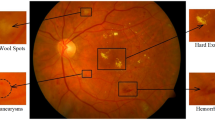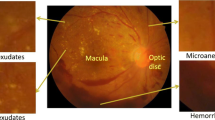Abstract
Diabetic Retinopathy (DR) is a chronic eye disease that is common in people who have had diabetes for a long time. If the disease is not treated during the early stages, it leads to complete vision loss, which can be avoided by treating in the early stages. The development of effective tools is critical for carrying out large-scale diagnostics at low cost while avoiding human bias. In this work, we propose a self-adaptive ensemble approach for retinopathy severity grading by stacking multiple dual attention based approaches. The proposed dual attention model leverages two distinct attention mechanisms. The model can focus on lesion-specific regions with the first level of attention, while the second level of attention allows it to learn correlations between spatial descriptors. The proposed model effectively predicts the severity level of retinopathy with dual levels of attention. We also present a self-adaptive meta learner for effectively stacking multiple dual attention models. Experimental studies on the benchmark APTOS 2019 dataset reveals that the proposed approach outperforms several existing models by achieving an accuracy of 86.22%. The proposed model exhibits generalization not only in terms of accuracy but also in terms of other evaluation measures, and achieves a quadratic kappa score of 89.65% and an AUC score of 96.47%.





Similar content being viewed by others
Data Availability Statement
Data sharing not applicable to this article as no datasets were generated or analyzed during the current study.
References
Alyoubi WL, Abulkhair MF, Shalash WM (2021) Diabetic retinopathy fundus image classification and lesions localization system using deep learning. Sensors 21(11):3704
Alyoubi WL, Shalash WM, Abulkhair MF (2020) Diabetic retinopathy detection through deep learning techniques: A review. Inform Med Unlocked 20:100377
Bodapati JD (2021) SAE-PD-Seq: sequence autoencoder-based pre-training of decoder for sequence learning tasks. Signal Image Video Process 15.7:1453–1459
Bodapati JD (2021) Modified self-training based statistical models for image classification and speaker identification. Int J Speech Technol 24.4:1007–1015
Bodapati JD (2022) Stacked convolutional auto-encoder representations with spatial attention for efficient diabetic retinopathy diagnosis. In: Multimedia Tools and Applications, pp 1–24
Bodapati JD, Rohith V (2022) ChxCapsNet: Deep capsule network with transfer learning for evaluating pneumonia in paediatric chest radiographs. Measurement 188:110491
Bodapati JD, Rohith V, Dondeti V (2022) Ensemble of deep capsule neural networks: an application to pediatric pneumonia prediction. Phys Eng Sci Med 45.3:949–959
Bodapati JD, Shaik NS, Naralasetti V (2021) Deep convolution feature aggregation: an application to diabetic retinopathy severity level prediction. In: Signal, Image and Video Processing, pp 1–8
Bodapati JD, Shaik NS, Naralasetti V (2021) Composite deep neural network with gated-attention mechanism for diabetic retinopathy severity classification. In: Journal of Ambient Intelligence and Humanized Computing. https://doi.org/10.1007/s12652-020-02727-z
Bodapati JD et al (2020) Blended multi-modal deep ConvNet features for diabetic retinopathy severity prediction. Electronics 9.6:914
Bodapati JD et al (2021) Msenet: Multi-modal squeeze-and-excitation network for brain tumor severity prediction. Int J Pattern Recog Artif Intell 35.07:2157005
Dekhil O et al (2019) Deep learning based method for computer aided diagnosis of diabetic retinopathy. In: 2019 IEEE International Conference on Imaging Systems and Techniques (IST), pp 1–4
Deng J et al (2009) Imagenet: A large-scale hierarchical image database. In: 2009 IEEE Conference on Computer Vision and Pattern Recognition, pp 248–255
Dondeti V et al (2020) Deep convolution features in non-linear embedding space for fundus image classification deep convolution features in non-linear embedding space for fundus image classification. Revue d’Intelligence Artificielle 34.3:307–313
Fukui H et al (2019) Attention branch network: Learning of attention mechanism for visual explanation. In: Proceedings of the IEEE/CVF Conference on Computer Vision and Pattern Recognition (CVPR)
Gao Z et al (2019) Diagnosis of diabetic retinopathy using deep neural networks. IEEE Access 7:3360–3370. https://doi.org/10.1109/ACCESS.2018.2888639
Gulshan V et al (2016) Development and validation of a deep learning algorithm for detection of diabetic retinopathy in retinal fundus photographs. Jama 316.22:2402–2410
Habib MM et al (2017) Detection of microaneurysms in retinal images using an ensemble classifier. Informat Med Unlocked 9:44–57
He A et al (2020) CABNet: Category attention block for imbalanced diabetic retinopathy grading. In: IEEE Transactions on Medical Imaging
Hu J, Shen L, Sun G (2018) Squeeze-and-Excitation Networks. In: Proceedings of the IEEE Conference on Computer Vision and Pattern Recognition (CVPR)
Kandel I, Castelli M (2020) Transfer learning with convolutional neural networks for diabetic retinopathy image classification. A Review. Appl Sci 10.6:2021
Kassani SH et al (2019) Diabetic retinopathy classification using a modified xception architecture. In: 2019 IEEE International Symposium on Signal Processing and Information Technology (ISSPIT), pp 1–6
Kaur N, Chatterjee S, Acharyya M, Kaur J, Kapoor N, Gupta S (2016) A supervised approach for automated detection of hemorrhages in retinal fundus images. In: 2016 5th International Conference on Wireless Networks and Embedded Systems (WECON), pp 1–5
Krause J et al (2018) Grader variability and the importance of reference standards for evaluating machine learning models for diabetic retinopathy. Ophthalmology 125.8:1264–1272
Kaggle K APTOS 2019 Blindness detection challenge. https://www.kaggle.com/c/aptos2019-blindnes-detection. Accessed 30 Dec 2019
Li X et al (2019) CANet: Cross-Disease Attention Network for joint diabetic retinopathy and diabetic macular edema grading. IEEE Trans Med Imaging 39.5:1483–1493
Long S et al (2019) Automatic detection of hard exudates in color retinal images using dynamic threshold and SVM classification: algorithm development and evaluation. In: BioMed Research International 2019
Luong M-T, Pham H, Manning CD (2015) Effective approaches to attention-based neural machine translation. In: International Conference on Learning Representations
Mateen M. et al (2019) Fundus image classification using VGG-19 architecture with PCA and SVD. Symmetry 11.1:1
Mohammedhasan M, Uguz H (2020) A new early stage diabetic retinopathy diagnosis model using deep convolutional neural networks and principal component analysis. Traitement du Signal 37.5:711–722
Naralasetti V et al (2021) Deep learning models for pneumonia identification and classification based on X-ray images. In: Traitement du Signal, vol 38.8
Noushin E et al (2019) Microaneurysm detection in fundus images using a two step convolution neural network. Biomed Eng Online 18.1:67
Prentašić P, Lonćarić S (2016) Detection of exudates in fundus photographs using deep neural networks and anatomical landmark detection fusion. Comput Meth Programs Biomed 137:281–292
Qummar S et al (2019) A deep learning ensemble approach for diabetic retinopathy detection. IEEE Access 7:150530–150539
Shaban M et al (2020) A convolutional neural network for the screening and staging of diabetic retinopathy. Plos one 15.6:e0233514
Srivastava RK, Greff K, Schmidhuber J (2015) Training very deep networks. Adv Neural Inf Process Systems 28:2377–2385. Curran Associates, Inc.
Wan S, Liang Y, Zhang Y (2018) Deep convolutional neural networks for diabetic retinopathy detection by image classification. Comput Electric Engi 72:274–282
Xu K et al (2015) Show, attend and tell: Neural image caption generation with visual attention. Proc Mach Learn Res 37:2048–2057
Zago GT et al (2020) Diabetic retinopathy detection using red lesion localization and convolutional neural networks. Comput Biol Med 116:103537
Author information
Authors and Affiliations
Corresponding author
Ethics declarations
Funding and/or Conflicts of interests/Competing interests
The authors did not receive support from any organization for the submitted work and authors do not have any conflicts of interest to declare.
Additional information
Publisher’s note
Springer Nature remains neutral with regard to jurisdictional claims in published maps and institutional affiliations.
Rights and permissions
Springer Nature or its licensor (e.g. a society or other partner) holds exclusive rights to this article under a publishing agreement with the author(s) or other rightsholder(s); author self-archiving of the accepted manuscript version of this article is solely governed by the terms of such publishing agreement and applicable law.
About this article
Cite this article
Bodapati, J.D., Balaji, B.B. Self-adaptive stacking ensemble approach with attention based deep neural network models for diabetic retinopathy severity prediction. Multimed Tools Appl 83, 1083–1102 (2024). https://doi.org/10.1007/s11042-023-15120-7
Received:
Revised:
Accepted:
Published:
Issue Date:
DOI: https://doi.org/10.1007/s11042-023-15120-7




